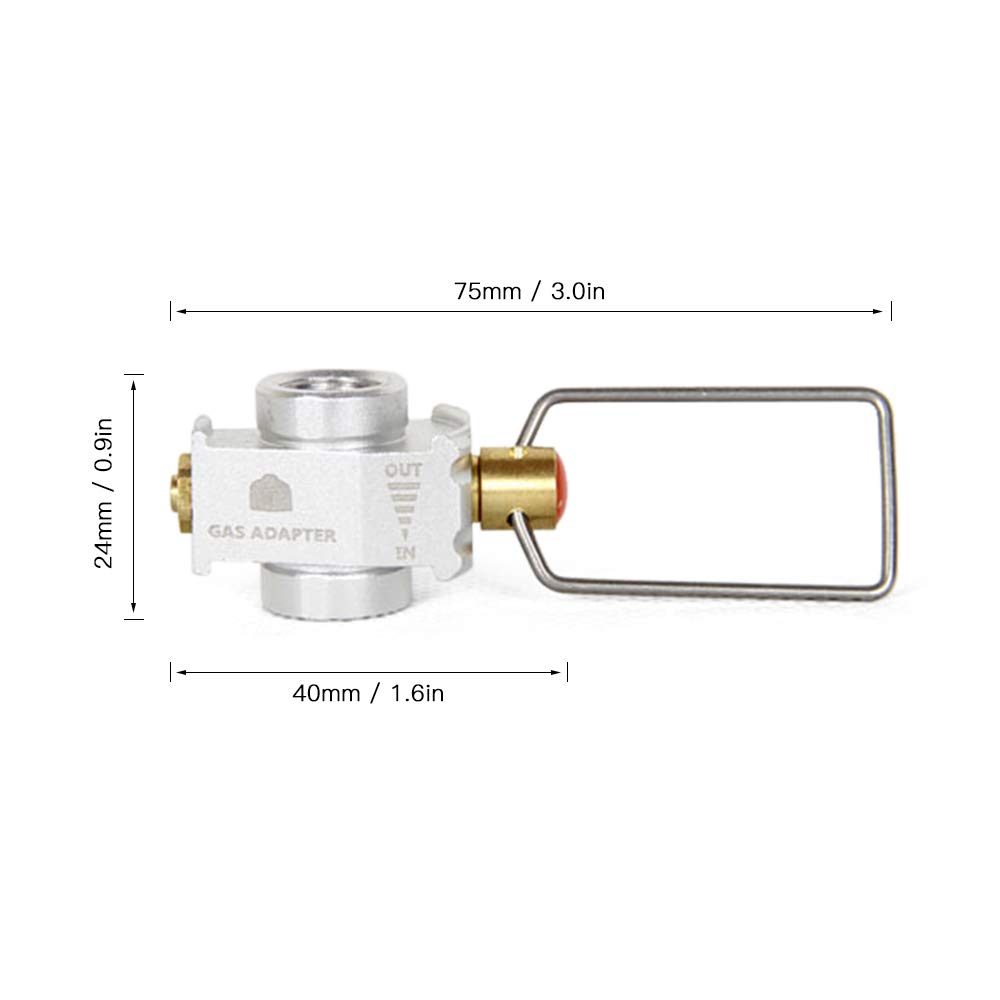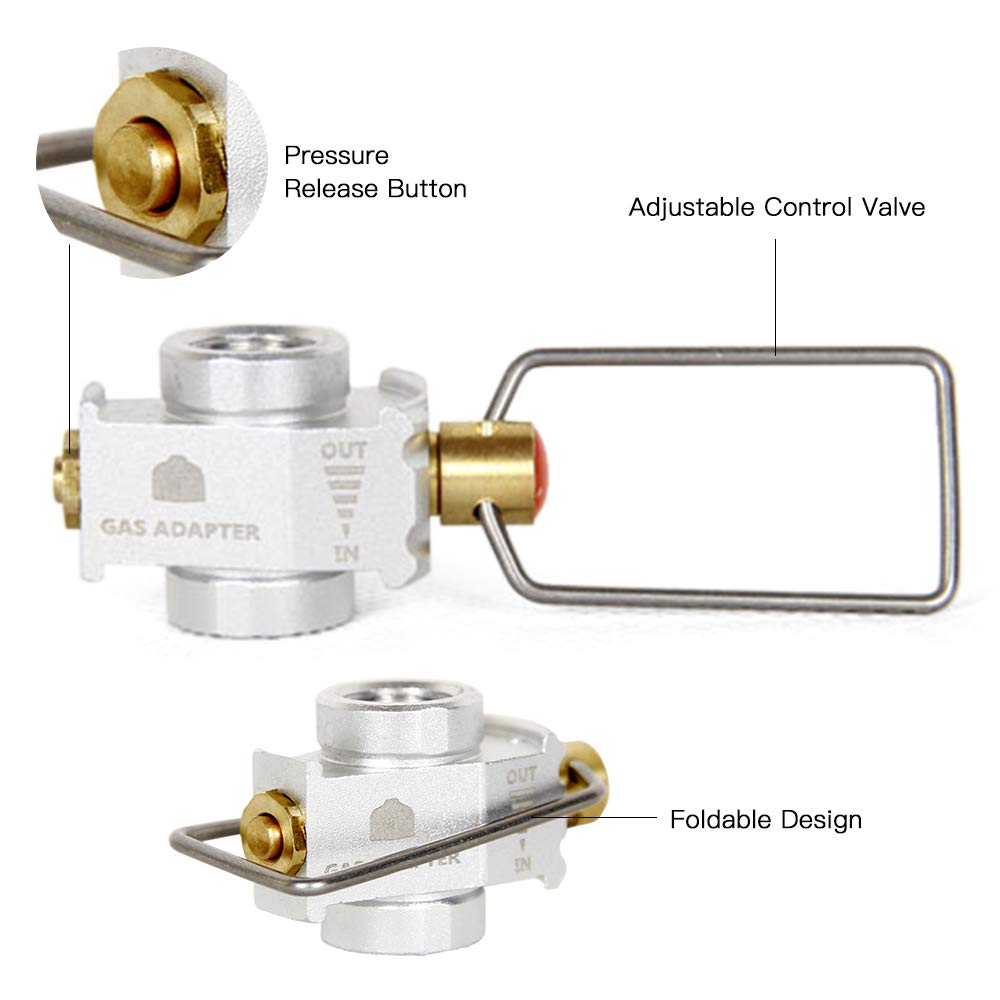





🔥 Fuel Your Adventures with Confidence!
The Lixada Gas Saver Plus is a versatile gas converter shifter designed for outdoor enthusiasts. Made from high-quality aluminum and copper, it allows you to efficiently refill your gas tanks while ensuring safety with its pressure release button and adjustable control valve. Lightweight and compact, it's perfect for camping, hiking, and picnics, making it an essential tool for eco-conscious adventurers.
| Material Type | Aluminum, Copper |
| Power Source | Gas Powered |
| Fuel Type | Liquefied Petroleum Gas |
J**H
Works great so far, already saved me money on fuel.
I've used it about 5 times to consolidate and transfer fuel between MSR Isopro fuel canisters. Much cheaper for me to buy the 16oz canisters and then transfer to a 4 or 8 oz canister that is empty or only partially full.How I use it: Weigh the canister you want to add fuel to, which will tell you how much is currently in there, with a postage scale. Put canister you want to take fuel from outside in the sun (if it's a warm sunny day). Put canister you want to receive fuel into the freezer. Wait 15 to 20 minutes. Collect both canisters. With valve in the off position, screw both canisters into the appropriate side of the transfer valve, making sure that the threads of the canister you are currently screwing in are facing up (otherwise you will get fuel spraying out if the threads face down while you're screwing in). Once both canisters are screwed onto the transfer valve, open the valve and allow fuel to transfer. Once transfer sounds complete, unscrew the receiving canister (with threads facing up) and re-weigh it to verify you added the amount of fuel you were trying to add. Repeat sun/freezer steps and transfer again if necessary.
A**L
Works great!
Very easy to use. I suggest watching a YouTube video first though. Just as good as the ones that are 3 times the price.
G**R
Mine broke soon; no guarantee yours won't, too
I accumulate a lot of partially empty iso containers. The typical solution is to bring one full one and one near-empty one, and use up the latter. But it is still too easy to end up with a lot.So I thought this would be a great tool to consolidate that fuel.And it was easy, and fun -- until the thing broke.I was able to empty out maybe six or seven canisters and fill up three, two small and one medium. Since there's no good way of measuring how much fuel has moved, that probably represents twenty or so connect/transfer/disconnect/weigh cycles.And then I noticed a little chunk of brass on the counter where there shouldn't be any such thing.On inspection, it was one of the two pins that press open the spring valve on a canister. Without that pin, no gas would transfer, so the gizmo is useless.A few days later, I tried epoxying it in place. But given the tiny amount of glue holding together dissimilar metals, I wasn't surprised when it didn't even last to a second transfer. It couldn't have helped that decompressing gas inside that chamber would cause a fast drop in temperature. I'll probably try other glues. (Maybe Permatex 14600 Cold Weld Bonding Compound — but do I want to throw more money at this?)So I got unlucky — the brass of that pin was probably cast poorly. I imagine there are other hidden ways something like this could be flawed. And, of course, the 'warranty' only covers if it arrives in your mailbox busted, not if it breaks soon after that.My recommendation: look for a model that actually has a better refund policy, or at least more positive reviews.Oh, here's how I used it — the process worked great:1) I made a note of what an empty canister and a full canister *should* weigh. I've only seen three sizes, and brand probably doesn't matter. I also made a note of how much the transfer gizmo weighs (24–25 grams).2) I weighed each canister, using a sticky note for each. I wanted to move fuel into the most-full ones, and empty out the most-empty ones first.3) I put a few of the most-full ones in the freezer, and let them stay there a few days. (A few hours should be sufficient.)The liquid in these is a blend of isobutane and propane, with maybe some n-butane from better brands for better cold-weather performance. It will still vaporize below freezing, but the vapor pressure will be dramatically reduced, making it easier to put more fuel in a cold target canister.4) I brought a pot of water to about 105–110°F. I've felt safe using these canisters on a hot summer day, and I suspect they were hotter than that at the time.5) I chose a cold target-canister and weighed it, making a note of roughly how much it should weigh when full. I screwed the transfer gizmo onto it, and put it back in the freezer, ready to go.6) I chose a source-canister, noting how much fuel I'd probably get from it. Then I put it in the hot water, weighted down so it stayed submerged, and busied myself in other ways for maybe ten minutes.7) I pulled the source-canister out of the water, dried it off, and screwed it to the other side of the transfer gizmo, and opened the valve.8) I listened to gas move from one to the other.8a) If I knew the amount of leftover gas in the emptying canister wouldn't overfill the target one, I waited until there was no further noise.8b) If there was more gas in the emptying one than I really wanted added to the target-canister, I waited until… well, until I thought it was wise to stop the transfer and check weights. I didn't really want to overfill anything.9) After unscrewing the source-canister, I weighed both.9a) If the source-canister was near empty, I compared it to my notes about how much an empty one would weigh, and shook it to listen for liquid. If it was empty, it went into the bag to take to the recycling center.9b) I left the transfer gizmo on the target-canister and weighed them, and compared that to my notes. Subtracting the weight of the gizmo confirmed how much fuel had moved, and I thought about how many seconds I'd let the fuel transfer and how fast fuel was flowing for future attempts.10) Given how fast the metal radiates cold and heat (and that the vaporizing gas would also very quickly cool down a source-canister) I put both canisters (maybe swapping out an emptied source canister) back in the respective cold/hot places and came back in ten minutes to repeat the process.It was fun, and felt worthwhile. I just wish the device had been better built.
M**D
90% effective
The device works as described, but no matter what I do there is still 5-10 grams of fuel left in the can I am emptying . I put the receiver in the freezer for an hour, the donor in the sun or on a heat vent for the same time, yet some fuel will not exit the donor when they are connected. Still, it is much better than it was, and I could carry several nearly empty cans on a one night trip where weight is less of an issue. Overall I recommend this product.
K**Y
Easy to use
I watched a lot of videos on how refill my own bottles. This tool worked great and will save me a lot of money.
J**1
Works for refilling 4oz isobutane canister
This is exactly the same as others selling for $32. I got this for $10 and somehow right after the price increased to $11. Just make sure to put the empty canister in the freezer for at least 15 minutes. Attach the empty canister, then the full canister (make sure it is not upside down). Then open the valve and as soon as hissing sound stops, the lower canister is full. I confirmed this by weight. 100% recommended.
M**T
Easy to use
I have a few tips...Get a scale and know how much a full canister weights before you start then the goal is to get as close but under as possible.Second, put the lower receiving canister in an ice bath and use a warm towel wrap on the upper canister to boost the transfer to nearly 100% from top to bottom.I used to take 2-3 half full canisters camping and now I only take a full one!
K**R
Got gas?
Let ‘er rip with this little gadget! Works great.
A**Y
Doesn't work, leaked all over the place.
Waste of money.
W**R
QUALITY BUILT!
A great build on product would be a 5 but have not had a chance to use it yet. Shipped faster than expected date.
Trustpilot
5 days ago
1 week ago